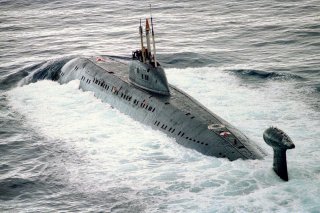How a U.S. Navy Nuclear Missile Submarine and Russian Attack Sub Collided
The U.S. Navy's USS James Madison and a Russian Victor-class Attack submarine smashed into each other in the 1970s. Remarkably, the incident is not well documented.
Named after the Founding Father who was credited with drafting the U.S. Constitution, the USS James Madison (SSBN-627) was the lead ship of a class of ballistic missile submarines – and she was involved in a Cold War incident that was largely kept quiet for decades.
It could have even led to World War III.
In fact, it was only in early 2017 after CIA documents were finally released that revealed that the U.S. Navy's nuclear-powered submarine collided with a Soviet nuclear-powered sub just 30 miles from Glasgow in shallow waters near Holy Loch, where the U.S. had a submarine base from 1961 to 1992.
A previously classified document, which had been sent to then-U.S. Secretary of State Henry Kissinger by Brent Scowcroft, national security advisor to President Gerald Ford, stated, "Have just received word from the Pentagon that one of our Poseidon submarines has just collided with a Soviet Victor-class submarine.
"The SSBN James Madison was departing Holy Loch to take up station when it collided with a Soviet submarine waiting outside the port to take up trail," the report added. "Both submarines surfaced and the Soviet boat subsequently submerged again. There is no report yet of the extent of damage. Will keep you posted."
Confirmation!
The declassified document corroborated a previously unconfirmed report published in the Washington Post on January 1, 1975, by investigative journalist Jack Anderson. The reporter had noted a nine-foot-long scratch on the side of the U.S. submarine that was a result of the collision.
Another "top secret" document actually noted the reporting of the incident.
"On 3 January, the NID [National Intelligence Daily] ran an item on the collision just off Holy Loch of US Polaris submarine and a Soviet attack submarine. Unfortunately, Jack Anderson had run the same news in the Washington Post a day or two earlier," it stated. "This pre-emption on Anderson's part forced the surfacing (no pun intended) of a piece of information in a current intelligence 2 months after the event occurred."
The cable was part of a mass release from the U.S. intelligence agency of more than 12 million pages of previously classified reports in 930,000 documents. The same data dump reportedly revealed that the CIA planned to give the Falklands Islands to Argentina if the South American nation won the 1982 war with the UK.
Collision Covered Up?
The extent of the damage to SSBN-627 remains unclear, but it was noted that the boat was taken into dry dock for inspection and repair. The boat had been in service for about a decade when the incident occurred.
In 2017, Dr. Eric Graham, a marine historian from Edinburgh University, told BBC Scotland it could have been a diplomatic incident – yet because it was so deep into the UK home water it was an "embarrassment" that they wanted to keep quiet.
"It shows how easily they penetrated our defence system and threatened the biggest toy in our arsenal," explained Graham, who noted that during the Cold War, the U.S. Navy depended on Holy Loch as the Polaris missile had a range of just 2,500 miles and couldn't have reached the Soviet Union from U.S. waters. The base was used to refit submarines to avoid returning to the U.S.
In addition, Graham said that while nuclear-powered submarines could essentially "disappear" into the deep Atlantic Ocean, the boats had a problem when coming out of the narrow confines of the Holy Loch and travelling through the channel between north Antrim and the Kintyre peninsula.
"The big shock with this Victor class submarine was that it was off Arran," said Graham. "It would not happen today. It is trying to shadow an American Polaris-carrying submarine coming out of the loch. Once it locks onto it, it can follow it out into its patrol zone."
Graham described it as a game-changer should there have been a hunter/killer sub behind every American Polaris-carrying sub. "You can actually have a first strike and take out America's first line of defence."
World War III?
Though no one was killed or apparently even seriously injured in the 1974 collision involving the USS James Madison, it could have been a spark that ended civilization as we know it.
"If the crew on one of the submarines had misinterpreted the collision as an attack and decided to defend itself and sink the other submarine [there could have been a disaster]," Hans Kristensen, a nuclear weapons expert, told Forces.net, also in 2017. "The submarines could also have capsized with loss of all on board, leaving 'hot' nuclear reactors in relatively shallow waters close to rich fishing grounds.
Cooler heads prevailed and the Cold War didn’t turn hot either.
Author Experience and Expertise
Peter Suciu is a Michigan-based writer. He has contributed to more than four dozen magazines, newspapers, and websites with over 3,200 published pieces over a twenty-year career in journalism. He regularly writes about military hardware, firearms history, cybersecurity, politics, and international affairs. Peter is also a Contributing Writer for Forbes and Clearance Jobs. You can follow him on Twitter: @PeterSuciu.


